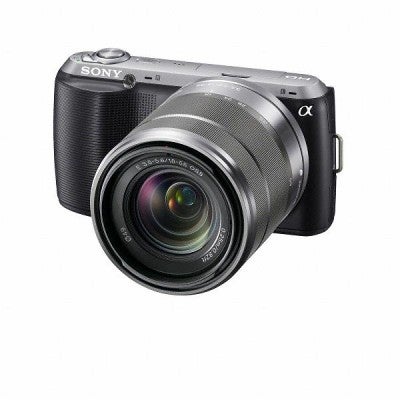The NEX-C3 is the latest compact addition to Sonyu2019s NEX Compact System Camera line up. We have the hands on Sony Alpha NEX-C3 previewu2026
The Sony NEX-C3 replaces the NEX-3 that came to the end of its production line earlier in the year. With the onus on small size – the ‘C’ in the name stands for ‘Compact’ – Sony has redefined the size limits for Compact System Cameras (CSC) with APS-C sized sensors. Indeed the NEX-C3’s 109.6 x 60 x 33mm body makes it the world’s smallest and lightest CSC, plus its width and height are comparable to a modern-day Smartphone. That’s quite an accomplishment, although non-pancake lenses do now completely dwarf the body by comparison.
On the inside of the NEX-3 is a brand new 16.2MP APS-C CMOS sensor, akin to that found in the Sony A580 and Nikon D7000. Judging from how well those other models perform in the image quality department our initial expectations are for very high-quality results. We were able to snap a number of shots with the camera but, given its state of infancy, these pre-release samples are not ones that we’re allowed to share with the wider public. As soon as we get our mitts on a final version we’ll endeavour to release full size image samples for evaluation.
Working alongside the sensor is Sony’s BIONZ processor that is able to render Raw and/or JPEG shots from ISO 200-12,800 as standard. Oddly there’s no ISO 100 option (not even by extension), a trait we’re seeing more and more manufacturers deliver. A 720p HD movie mode complements the stills shooting, with files rendered as MP4 files in camera.
A 3in, 921k-dot, tilt-angle LCD screen features on the rear, and there’s Sony’s unique fitting to attach a flash (included in the box) on top of the camera. For more power a new HVL-F20S flashgun with a Guide Number of 20 (at ISO 100 equivalent) will also be made available as an optional accessory. However, there’s still no sign of an optional electronic viewfinder – but, who knows, as the range develops this could be something else that will come to be.
The NEX-C3 also introduces a ‘Photo Creativity’ mode. This includes the Background Defocus, Sweep Panorama (also in 3D), HDR (High Dynamic Range), Anti-Motion Blur and Handheld Twilight modes of the previous generation NEX cameras, but also adds some extra surprises. Soft Skin Effect adds a three-tier skin-softening ‘beauty’ function, while Picture Effects encompasses seven options – Partial Color, Toy Camera, High Key, Posterization (black and white or colour), Retro, High Contrast Mono and Pop Color – that work in real-time preview on the LCD screen. The preview appears generally fluid and the modes will work for both stills and movie shooting, but the inability to apply modes to existing JPEG files or to shoot Raw + JPEG with any option in play is a bit of a let down. Existing NEX-3 and NEX-5 users can also expect a firmware upgrade with these new Photo Creativity modes to appear when the NEX-C3 hits the shelves later in the year.
There’s also a new ‘Peaking’ function for manual focus assist. Ignoring its unusual namesake for the moment (it does sound like something straight from a Japanese translation book), this quirky option applies a red, white or yellow (as user-selected) edging to in-focus subjects. This works with all lenses, including those connected via an adaptor so will be ideal for those looking to utilise both Alpha and other third party lenses with the latest NEX setup. At present the mode does feel far from finished – opening the aperture right up fails to define a different area of focus to when the same aperture is stopped right down. Should it be refined in Sony’s labs over the next few months, however, then this could be a winning mode to have.
Of the few moans we had regarding the previous NEX-3 release, the NEX-C3 looks to have stepped up to the mark: Start-up time is now even faster, plus the rear d-pad is user-customisable in all four directions for a more controlled user experience. Battery life also sees an overhaul, now able to offer some 400 shots per charge (CIPA standard). However the menu system can, at times, feel a little clunky when it comes to finding specific options – but to have totally redesigned this layout would have undermined the original NEX range.
Available in black or silver options (or pink in some non-UK territories), the Sony Alpha NEX-C3 is due for release this August, with prices yet to be confirmed. The black option with its silver top-plate certainly looks the part. We’ll be bringing you a full review as soon as a final model lands in our laps at the WDC office…
Sony Alpha NEX-C3 – Highlights
World’s smallest and lightest Compact System Camera
16.2MP APS-C CMOS sensor
ISO 200-12,800 sensitivity
720p HD Movie (MP4 format)
921k-dot, tilt-angle LCD
Detachable flash unit included
25-area AF system
49-segment metering
1/4000th – 30 sec exposure
‘Peaking’ function for manual focus assist
Manual, Auto+ and Photo Creativity control
Enhanced battery life (400 shots per charge)





